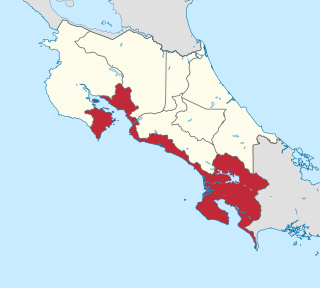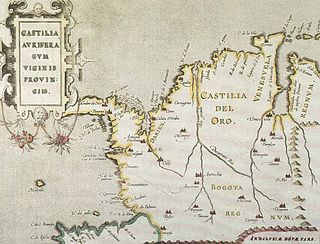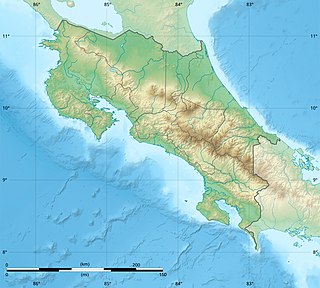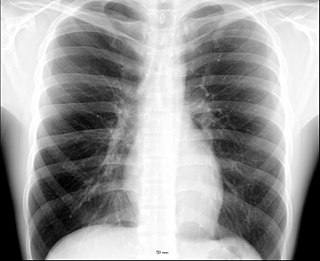
Costa Rica, officially the Republic of Costa Rica, is a country in Central America, bordered by Nicaragua to the north, the Caribbean Sea to the northeast, Panama to the southeast, the Pacific Ocean to the southwest, and Ecuador to the south of Cocos Island. It has a population of around 5 million in a land area of 51,060 square kilometers. An estimated 333,980 people live in the capital and largest city, San José with around 2 million people in the surrounding metropolitan area.

Costa Rica is located on the Central American Isthmus, surrounding the point 10° north of the equator and 84° west of the prime meridian. It borders both the Caribbean Sea and the North Pacific Ocean, with a total of 1,290 km of coastline.

Puntarenas is a province of Costa Rica. It is located in the western part of the country, covering most of Costa Rica's Pacific Ocean coast, and it is the largest province in Costa Rica. Clockwise from the northwest it borders on the provinces Guanacaste, Alajuela, San José and Limón, and the neighbouring country of Panama.

Manuel Antonio National Park, in Spanish the Parque Nacional Manuel Antonio, is a small National Park in the Central Pacific Conservation Area located on the Pacific coast of Costa Rica, just south of the city of Quepos, Puntarenas, and 132 km (82 mi) from the national capital of San José. Established in 1972 with a land area enumerating 1 983 ha, it is the destination of as many as 150,000 visitors annually and well known for its beautiful beaches and hiking trails. In 2011, Manuel Antonio was listed by Forbes among the world's 12 most beautiful national parks.

Santa Rosa National Park, in Spanish the Parque Nacional Santa Rosa, is a national park, in Guanacaste Province, northwestern Costa Rica. It was the first national park established in Costa Rica, created in 1971.

The Las Baulas National Marine Park, in Spanish Parque Nacional Marino Las Baulas is a National Park of Costa Rica, part of the Tempisque Conservation Area, and covers approximately 43.243 acres marine just north of the town of Tamarindo. It supports the largest nesting colony of leatherback sea turtles on the Pacific coast of the Americas. Female leatherbacks often come ashore at Playa Grande between October and May to lay their eggs.

Poás Volcano National Park, in Spanish Parque Nacional Volcán Poás, is a National Park in Costa Rica that covers an area of approximately 65 square kilometres ; the summit is 2,700 metres (8,900 ft). It was established on 25 January 1971. Until recently visitors could usually walk all the way to the edge of the main crater, but on 13 April 2017 the park was closed to visitors due to an explosive eruption on the evening of 12 April. Still further eruptions, including Easter, 16 April, have closed the park until further notice.

Castilla de Oro or del Oro was the name given by the Spanish settlers at the beginning of the 16th century to the Central American territories from the Gulf of Urabá, near today's Colombian-Panamanian border, to the Belén River. Beyond that river, the region was known as Veragua, and was disputed by the Spanish crown along with the Columbus family. The name "Castilla de Oro" was made official in May 1513 by King Ferdinand II of Aragon, then regent of the Crown of Castile.

Playa Grande, also known as Salinas, is a beach community on the Pacific coast of Costa Rica just north of Tamarindo. Playa Grande is internationally popular as one of Costa Rica’s best surfing spots as well as being part of Parque Nacional Marino Las Baulas, a nesting ground of the largest marine reptile, the leatherback turtle.

The yellow-billed cotinga is a species of bird in the family Cotingidae. It is found near the coast in Costa Rica and the extreme western part of Panama. Its natural habitats are subtropical or tropical moist lowland forest, subtropical or tropical mangrove forest, and subtropical or tropical moist shrubland. It is threatened by habitat destruction.
The Central America bioregion is a biogeographic region comprising southern Mexico and Central America.

The following outline is provided as an overview of and topical guide to Costa Rica:

The village of Cabo Matapalo is at the outermost point of the Osa Peninsula, in the southern Pacific coast area of Costa Rica.
Mccoskerichthys sandae, the Tufted blenny, is a species of chaenopsid blenny, found around Costa Rica and Panama, in the eastern central Pacific ocean. It can reach a maximum length of 8 centimetres (3.1 in) TL. This species feeds primarily on small crustaceans including copepods, amphipods, and ostracods. It is the only known member of its genus.
Aphelochaeta antelonga is a species of bitentaculate cirratulidan first found in the Pacific coast of Costa Rica, at a shallow subtidal depth of about 11 to 18 metres in the Gulf of Nicoya. It is characterised by possessing a long biannulate peristomium and fibrillated capillary setae.
Aphelochaeta praeacuta is a species of bitentaculate cirratulidan first found in the Pacific coast of Costa Rica, at a shallow subtidal depth of about 11 to 28 metres in Bahia Culebra. It is characterised by possessing a first peristomial annulation that extends as a dorsal crest over the second annulation and first setiger.
Aphelochaeta striata is a species of bitentaculate cirratulidan first found in the Pacific coast of Costa Rica, at a shallow subtidal depth of about 11 to 28 metres in the Gulf of Nicoya. It is characterised by possessing a narrow body and transverse blue stripes across the venter of its setigers 5 through 8.
Aphelochaeta zebra is a species of bitentaculate cirratulidan first found in the Pacific coast of Costa Rica, at a coral reef in Golfo Dulce. It is characterised by possessing an expanded posterior end and by its darkly-staining intersegmental regions.












